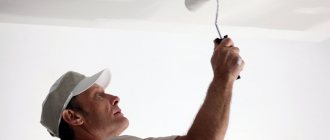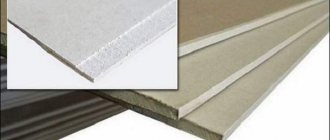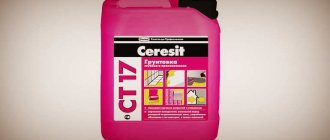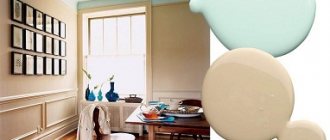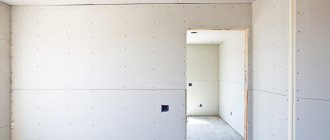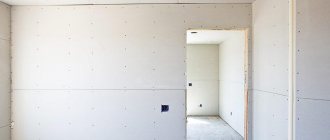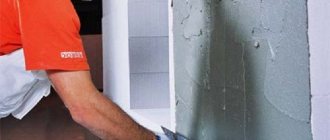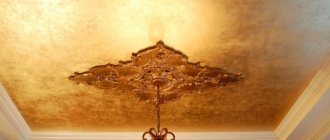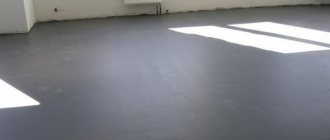Completion of repairs and most finishing and restoration work are rarely accomplished without the use of putty. The choice of this material for leveling various surfaces is complicated by the variety of types and the range presented in each category. The growing popularity of polymer compounds also forces a beginner in finishing work to decide whether latex putty or acrylic putty is better, which is better for a particular surface, which one is universal, and which one is cheaper.
Classification of putties
The entire variety of leveling compounds, according to the degree of working readiness, is divided into dry mixtures, which require the addition of water and mixing before use, and ready-to-use materials. From the stage at which they are used, a distinction is made between starting putty - for preparatory (rough) leveling and finishing putty - for fine (final) processing of the base surface before painting.
Working with the starting mixture
Decorative putty can be included in a separate category.
The use of finishing polymer mixtures for surface decoration
For your information! The purchase of a dry powder mixture is justified by the possibility of dosed preparation of the working composition with a viscosity convenient at this stage of work. The dry mixture is also convenient for transportation and storage, and has an extended shelf life.
Gypsum is the most popular putty for interior finishing work
. The main classification criterion is the used version of the basic binder component. According to him, there are the following types of putty:
- Cement based. Inexpensive compositions, not afraid of frost and humidity, universal (for interior and facade work), durable. To obtain certain characteristics, in addition to cement, other binders are added. Suitable for leveling significant differences (up to 15 mm). The disadvantage is the coarse grain size and the time it takes for the mixture to set.
- Plaster. Eco-friendly, “breathable” and economical finely dispersed mixtures for interior decoration. The applied composition sets quickly, is easy to sand, and has good adhesion to many materials. Among the disadvantages, we note the low resistance to mechanical stress and the need for rapid production of the prepared composition.
- Polymer putty on an acrylic or latex basis. This class will be discussed in more detail below.
- Adhesive, consisting of glue (up to 10% of the mass), chalk and drying oil. Elastic, easy to apply, sands well. Used for internal preparation of surfaces for painting.
- Oil, consisting of chalk, drying oil and an auxiliary composition (drier) for quick drying of the putty. Features of the mixture: elasticity, moisture and frost resistance, not afraid of ultraviolet radiation, compatibility with many materials (including wood), versatility.
Oil compositions are indispensable for mechanized leveling of large surfaces
Composition and technical characteristics
The composition of the mixture may include many different fillers. One example is a material such as marble. It is added in small quantities, but it is difficult to overestimate its benefits. Thanks to marble, acrylic putty has the ability to linger on various surfaces, including wood. Depending on the application, filler is selected.
Specifications:
- drying time – 12 hours, at 20 degrees Celsius;
- layer thickness – less than 5 mm;
- density – 1.8 kg/m3;
- application must be carried out at a temperature of at least 12 degrees;
- storage period – 1 year.
Drying depends primarily on the thickness of the application layer. If you apply a small layer, the solution can dry within 4-6 hours. In this case, an important element during drying is moisture. The lower the humidity in the room, the faster it dries.
Important. If the place of purchase does not adhere to storage rules, then it is advisable to take the putty elsewhere. It must be remembered that if the solution freezes and then thaws, it loses many of its properties necessary for functioning.
Consumption per 1 m2
The consumption of this material is measured in kilograms. In order to paint 1 m2 of wall or other surface, you need to spend 1, 1 or 1.2 kg.
Acrylic putty
A type of polymer mixture whose binder base is acrylic. Release form: ready-to-use paste-like composition in a factory-sealed container.
Basic properties
General distinctive properties of all compounds in this group:
- Excellent adhesion to various substrates.
- Tolerance (without destruction or loss of original properties) of critical temperatures, their sharp fluctuations, ultraviolet radiation, and high humidity.
- Environmentally friendly.
- Elasticity.
- Durability.
- No shrinkage during curing and drying.
- Availability of thermal insulation qualities.
Disadvantages and advantages over gypsum
When compared with gypsum putties, it is worth highlighting the following advantages:
- Durability and strength of the resulting coating, resistance to mechanical damage.
- Water resistance and resistance to fungal attack expands the range of application - facade surfaces, bathrooms, steam rooms, kitchens and other rooms with high humidity.
- When temperature changes, the coating does not crack or crumble, as is the case with gypsum compositions.
Let's add to the cons:
- high price;
- almost no vapor permeability, thanks to which the gypsum finish regulates and maintains a comfortable level of humidity in the room;
- the need to treat the surface in several thin layers, where one pass is made with gypsum;
- Despite the lack of toxicity and safety for humans, acrylic putty still contains artificial components.
Sample packaging of ready-to-use acrylic putty
Subtleties of use
If you pay attention to the following points, the workflow will be simplified and the results will not disappoint.
- When leveling ceilings, select a denser mixture.
- To work with walls, it is advisable to purchase water-dispersion compounds.
- It is better to carry out work on façade surfaces in warm but cloudy weather. In hot weather, the walls are moistened with a sprayer.
- The second layer is applied thinner than the previous one.
- For application to wood or metal, in order to protect these materials from destruction, water-repellent putty is used.
Application Tips
Here are some useful recommendations from practitioners:
- As the ambient temperature decreases, the elasticity of the working mixture decreases. This feature must be taken into account.
- When working, the putty must be stirred from time to time.
- For multi-layer application, a total thickness of 10 mm is allowed. Each layer must dry completely, then it is sanded and primed.
- You should not hesitate with the acrylic composition; it hardens quickly after application.
- To level metal surfaces, it is advisable to select the putty to match the base.
- The finishing layer on wood is carried out along the grain and as smooth as possible, because it is usually not sanded.
DIY putty. Types of putties and methods of applying them
Puttying walls and ceilings is necessary to level surfaces and prepare them for finishing or, as it is called, finishing. In order to professionally produce putty with your own hands, you need to at least understand the types of putty and how to apply them.
Putty is divided into several types. It can be oil, glue, varnish and gypsum
Oil-adhesive putty is used for interior finishing work. This putty consists of drying oil, acrylate, plasticizers, various additives and water. Latex putty is almost identical in purpose and composition to oil-adhesive putty. The only difference is that it contains calcite filler. So, to level the surface and hide defects in walls and ceilings (wooden, concrete, plastered), latex or oil-adhesive putty should be used.
Acrylic putty can be considered more “advanced”. The fact is that it can be used not only for leveling almost any surface, but also for restoring damaged plaster. Therefore, when carrying out cosmetic putty on walls or ceilings with your own hands, use an acrylic mixture. It is environmentally friendly, does not crack after drying, and can be easily sanded with sandpaper.
There is an acrylic putty designed for exterior finishing. It is also environmentally friendly, resistant to moisture, fits perfectly on wood, plaster and concrete, has increased strength and is easily processed with sandpaper. Repair of cottages and country houses, as a rule, cannot be done without acrylic putty.
Oil putty is intended for preparing surfaces that may come into contact with moisture. It is used when processing window sills, entrance doors, floors and window frames. Oil putty is resistant to moisture and has increased strength. However, it dries out slowly.
PVA-based putty is good because it contains special aseptic additives that resist the formation of fungus and mold. It can be used when working with plasterboard, plastered, concrete and asbestos-cement surfaces.
Technology of working with putty
The method of applying putty is not complicated. It is enough to sweat over a few meters of the surface being treated so that you can putty it with your own hands quite well. The tools you will need are wide and narrow spatulas and a container with a flat bottom. Work equipment will also not be superfluous - work with gloves, a hat and safety glasses.
Before starting work, it is necessary to coat the surface to be treated with a primer. In addition, you should pay attention to the temperature in the room - it must correspond to that indicated in the instructions for use of the type of putty used. At the very least, the internal temperature should not be lower. Also, do not forget to turn off the power to the electrical wiring. And one more thing - rough work on the ceiling must be completed.
In order to determine the normal working density of the solution, you need to make sure that the diluted putty adheres well to the spatula and to the vertical surface. If the solution thickens too much, add primer or water.
The solution must be stored in a closed container so that it does not harden until the work is completed. Using a narrow spatula, spread the solution evenly over the working surface of a wide spatula. After this, the solution should be applied with both vertical and horizontal movements, adjusting the thickness of the layer by the angle of the wide spatula. After the last layer is applied, you need to let the solution dry for at least a day. Then the surface should be treated with fine sandpaper.
In order to remove unevenness, you need to wait until the putty thickens, but does not dry completely. After this, the surface must be carefully washed with a primer. And only after that they wait until it dries completely and start sanding. As a rule, when puttingtying a ceiling or walls, you are not limited to one layer of mortar. In order to obtain a perfectly flat surface, apply two or three layers of putty.
The solution is not applied to the bare surface, but to a painting mesh, which is glued to the first layer. The painting mesh acts as a kind of reinforcement and, thereby, prevents the formation of cracks after painting the surface. There may be cracks on the walls that are invisible at first glance. However, it is enough to paint the surface and they will show themselves.
As a result, the treated surface should be perfectly smooth to the touch. The presence of scratches, roughness and unevenness is unacceptable. To more accurately check the surface, you can use a long ruler or a building level.
And, of course, if you don’t want to delve into such subtleties, entrust the work to professionals and renovating your apartment will give you only positive emotions.
Source: https://alfa-remont.com/articles/shpatlevka/
Latex putty
Latex mixtures are produced on a rubber base. Both ready-to-use and dry formulations are available for sale.
Basic properties
The main characteristics have something in common with acrylic compositions. But the fact that latex is made on the basis of natural or synthetic rubbers (that is, it can be considered rubber) makes the putty material more elastic, durable, resistant to abrasion and unwanted mechanical stress.
Disadvantages and advantages over gypsum
The comparative analysis of acrylic with gypsum given above can be applied to all polymer putties. True, it is worth adding superlatives to latex compositions in some characteristics. So, they are more durable, more wear-resistant, and more elastic. At the same time, they are more expensive and more “non-breathable”, since they practically do not allow moisture vapor to pass through.
An example of factory packaging of dry latex putty
Subtleties of use
Characteristic features of using latex putty:
- Before use, the bucket with the finished mixture must be kept at the work site for at least 2-4 hours to equalize the temperature.
- After application and drying, the latex layer cannot be sanded using abrasives or mesh. Even before hardening, remove all excess and eliminate defects with a slightly damp soft sponge.
- For exterior finishing, purchase a composition with the appropriate mark on the packaging, since the other options are intended for interior work.
- It is not recommended to exceed the layer thickness. The maximum value is 3 mm.
Application Tips
Tips from the masters will help you cope with the finishing without mistakes:
- The composition easily releases moisture, this is true even for a pre-primed surface. Therefore, it is advisable to moisten the base, and in hot weather this must be done.
- First, using a narrow spatula, fill deeper cracks and other defects. Then a thin leveling layer is applied with a wide tool.
- If you purchased a bucket with a large volume of mixture, then you will need a small container for work so that the entire solution does not dry out.
Workflow Features
The use of latex putty is practically no different from other types of compounds, however, some nuances are still present (also find out how you can finish the stove in your home).
Preparation for work
This includes the following activities:
- The surface area is measured, and depending on the expected thickness of application, the required volume of putty is calculated. The consumption of the composition can be found out from the seller, in addition, the instructions on the bucket contain all the necessary information.
- Be sure to purchase a deep penetration primer, with the help of which the base is strengthened and moisture absorption is reduced, which is very important for ease of work.
- Serpyanka for seams is also a must-purchase; it will protect your surfaces from cracks at the joints.
Make sure you purchase the necessary equipment:
- Two spatulas - narrow (about 10 cm) and wide (no wider than 35 cm). With their help, all basic work will be performed.
- Container for the composition; keeping a large bucket open is impractical - moisture will evaporate from it. It's easier to take it from the bucket as needed.
- A grater with a foam layer - this device is atypical for ordinary work; leveling is done with sandpaper.
This type of grater is needed to give the surface a perfect smoothness.
Main works
This includes preparatory activities and application operations:
- Surfaces must be cleaned of any remnants of old coatings, after which the walls must be vacuumed to remove dust.
- The next stage is treatment with a deep penetration primer. It will strengthen the base, especially the highly absorbent areas.
Primer is an important stage of work
- If work is carried out on drywall, then the screw heads and seams are sealed. First, a sickle mesh is glued to the joints, after which the entire heat-affected depression on the sheets is filled with the compound using a spatula.
Advice! Before using the composition, it is necessary to keep it indoors. In summer, a few hours are enough, in winter half a day, or better yet, a day.
- After the composition has dried, another primer is applied to the surface; this is very important, since in this way the absorption of the surface will be uniform over the entire area.
- The base layer is applied with a wide spatula in a thin layer; you should monitor the thickness of the coating and not allow it to be too thin - this will make rubbing difficult.
Important! Sometimes when applied at temperatures above 30 degrees, the problem arises that the composition dries too quickly. It is best to pre-treat the surface with a sprayer.
- Rubbing is carried out until it dries completely with a grater with damp but not wet foam rubber; movements should be moderately intense.
When treating the surface, water should not flow from the foam rubber.
Main differences
Both putties from the polymer class are very similar in many characteristics and properties. But there are also significant differences that should not be forgotten and must be taken into account when selecting a working mixture.
Study the characteristics and features of the putty before use
Thus, latex putties may have higher viscosity and will require a certain experience of the performer when applying. They allow the application of ultra-thin coatings without any loss or reduction in the quality of the material. When latex hardens, it forms a surface film that does not absorb paint, which helps to significantly reduce paint consumption.
When professionally applied, a thin layer of material can replace paint and varnish composition. After freezing, the finished working mixture loses its properties and becomes unsuitable for use. Acrylic mixtures are cheaper, they are more often used for facade and other exterior decoration. The applied coating has greater vapor permeability. Unlike latex analogues, the material is recommended for working with metal surfaces.
Recommendations for selection
Purchasing the required composition is a very important part of the repair work. In addition to the main characteristics, pay attention to the following points:
- You should not purchase putty that is older than a year.
- For beginners, it is better to buy ready-to-use formulations.
- Consider the place of production. The closer the manufacturer is, the better the characteristics of the product are preserved.
- The universal composition can be used to apply the starting layer and finishing coat.
- In winter, buy ready-made mixtures in closed and heated retail outlets.
- For facades, mixtures are selected that indicate frost resistance on the label.
- Do not forget that acrylic mixtures with a wood texture are specially produced for wood.
- For facades, it is more economical to buy working material in large packages.
It cannot be stated unequivocally that some kind of putty - latex or acrylic - is certainly considered the best option for leveling surfaces. Each composition has features, advantages and limitations. They should be taken into account when choosing, and also pay attention to the presence in mixtures of additives and components responsible for certain properties. Any putty mixtures are in demand, and a professional will choose the most suitable option for a specific object, taking into account many nuances.


